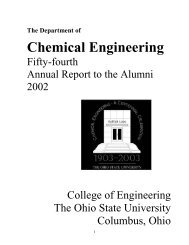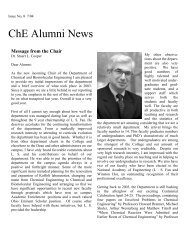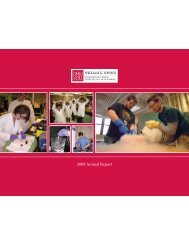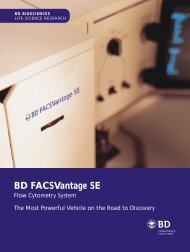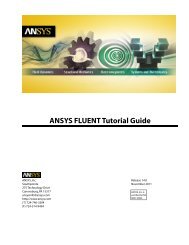2008 Annual Report - Chemical and Biomolecular Engineering ...
2008 Annual Report - Chemical and Biomolecular Engineering ...
2008 Annual Report - Chemical and Biomolecular Engineering ...
Create successful ePaper yourself
Turn your PDF publications into a flip-book with our unique Google optimized e-Paper software.
<strong>Chemical</strong> Reaction<br />
Networks Can Behave in<br />
Unexpected Ways<br />
For many years, Professor Martin Feinberg <strong>and</strong> his students<br />
have explored the mathematics of complex networks of chemical<br />
reactions. In nature, one typically has several – <strong>and</strong> often very<br />
many – chemical reactions occurring simultaneously, with<br />
reactants both produced <strong>and</strong> consumed by the various reactions.<br />
The governing equations are highly complex, <strong>and</strong> reaction<br />
rate constants appearing in those equations are often known<br />
only approximately, if at all. Feinberg’s research has pioneered<br />
chemical reaction network theory, which seeks to draw firm<br />
theoretical relationships between qualitative aspects of reactor<br />
behavior <strong>and</strong> structure of the underlying network of chemical<br />
reactions.<br />
At least in an isothermal setting, most reaction networks – even<br />
highly complex ones involving hundreds of species – behave<br />
in surprisingly stable ways, regardless of parameter values. In<br />
the context of a continuous flow stirred tank reactor (CFSTR),<br />
for example, there is typically just one steady state solution of<br />
the governing equations, <strong>and</strong> transient solutions tend toward<br />
that steady state. Recent work with graduate student Gheorghe<br />
Craciun has gone a long way to explain why this is so. (Craciun<br />
is now an Assistant Professor of Mathematics <strong>and</strong> <strong>Biomolecular</strong><br />
Chemistry at the University of Wisconsin.)<br />
More generally, Feinberg’s work has been receiving substantial<br />
attention in disciplines outside of chemical engineering, notably<br />
in biology <strong>and</strong> mathematics. Recently, for example, he has been a<br />
principal lecturer at conferences on Synthetic Biology in Zurich<br />
<strong>and</strong> in Groningen, <strong>and</strong> he has been an invited speaker in biology<br />
departments at Harvard University, Rockefeller University,<br />
<strong>and</strong> the Weizmann Institute of Science. He has given invited<br />
mathematics lectures at the Courant Institute (NYU), Fields<br />
Institute (Toronto), University of North Carolina, Georgia Tech<br />
<strong>and</strong> Duke University.<br />
Cooper Elected to Governing Board<br />
of Council for <strong>Chemical</strong> Research<br />
Stuart L. Cooper, professor <strong>and</strong> chair of the Lowrie Department of <strong>Chemical</strong> <strong>and</strong> <strong>Biomolecular</strong><br />
<strong>Engineering</strong>, has been elected to the Governing Board of the Council for <strong>Chemical</strong> Research. CCR is<br />
an organization that recognizes <strong>and</strong> facilitates basic research in the chemical sciences <strong>and</strong> engineering.<br />
Its purpose is to benefit society by advancing research in chemistry, chemical engineering <strong>and</strong> related<br />
disciplines through leadership collaboration across discipline, institution <strong>and</strong> sector boundaries.<br />
Winter Chosen for H.C. “Slip” Slider<br />
Young Faculty Professorship<br />
Assistant Professor Jessica Winter has received the H.C. “Slip” Slider Young Faculty Professorship in<br />
<strong>Chemical</strong> <strong>and</strong> <strong>Biomolecular</strong> <strong>Engineering</strong>. Winter joined Ohio State in 2006 after completing her graduate<br />
degrees at the University of Texas at Austin. In her postdoctoral work, she examined the application<br />
of tissue engineering techniques to neural prosthetic devices at the Center for Innovative Visual<br />
Rehabilitation, a collaborative effort between Harvard Medical School <strong>and</strong> MIT. Her primary research<br />
interest is the exploration of the relationship between nanoparticles <strong>and</strong> biological elements. She directs<br />
the Laboratory for Neural Nanoprobes <strong>and</strong> Prosthetic Devices, where research pursuits are focused on the<br />
development of micro- <strong>and</strong> nanoscale biomaterials that can be used to modulate nerve cells.<br />
The Slider Professorship was established in <strong>2008</strong> by William G. Lowrie, a 1966 <strong>Chemical</strong> <strong>Engineering</strong><br />
alumnus, <strong>and</strong> his wife Ernestine, in appreciation of the late Professor Slider’s teaching <strong>and</strong> mentoring.<br />
Celebrating the establishment of the H.C. “Slip” Slider Young Faculty Professorship are Interim Dean Gregory<br />
Washington, Slider Professor Jessica Winter, Bill Lowrie, Mrs. Jennie Slider, Mrs. Ernie Lowrie <strong>and</strong> former<br />
Dean Bud Baeslack.<br />
7




